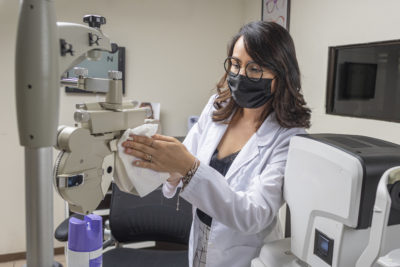Key Takeaways
- Eye Health is connected to diet, with nutrients such as vitamins and minerals that can help prevent eye diseases and degeneration.
- Foods rich in Vitamin E, lutein, and zeaxanthin, such as nuts, corn, and spinach are good for eye health.
- Omega-3 fatty acids from fish and antioxidants from fruits such as oranges and papayas can keep eye conditions from developing.
- Eye exercises, the 20-20-20 rule, and home remedies such as using amla improve eyesight naturally.
- There are dietary supplements full of Vitamin A, Omega-3, and lutein that can help eye health, but consult a doctor before taking any supplements.
Eye problems are biggest problem in today’s world as we are always glued to gadgets. Besides this every age group has its own set of eye problems.
Staying fit and healthy is the most popular buzzword of the current times. Taking good care of your eyes, to protect and maintain your eyesight, is also very vital for leading healthy lifestyle. It is an undeniable fact that your eyesight is closely dependent on your food preferences. Different types of nutrients in food help to prevent a wide range of eye diseases and also protect your eyes from age-related muscular degeneration.
Healthy Food is basic need for healthy body. Healthy Food includes a balanced combination of Carbohydrates, fats, Minerals, Vitamins, Proteins, Fibers and water.
Various nutrients especially minerals and vitamins are essential for beautiful and attractive eyes and clear sight. Let’s understand various commonly available sources of essential nutrients and their role in keeping our eyes healthy.
- Nuts and Dry Fruits
Snacking on nuts like almonds, apricots, cashew nuts etc. is good for eyes. They are rich in Vitamin E, which help in preventing cataract and age-related macular degeneration.
- Corn
Lutein and zeaxanthin are the predominant Carotenoids in corn. These two accounts for approximately 70% of carotenoid content of the human retina (light sensitive inner Surface of the eye) where they protect against oxidative damage caused by blue light. High levels of these carotenoids in the blood are strongly linked with reduced risk of both macular degeneration and cataracts.
- Kiwi fruit
Three or more servings of kiwi fruit per day is suggested in one study to decrease macular degeneration by 30%. This is thought to be associated with the kiwi’s high levels of lutein and zeaxanthin-both of which are natural chemicals found in the human eye.
- Grapes
Resveratrol present in grapes can protect against Diabetic Neuropathy and Retinopathy, conditions caused by poorly controlled diabetes where vision is severely affected. It reduces the effects of natural changes and damage associated with diabetic Neuropathy.
- Spinach
Spinach is a rich source of riboflavin and thiamine as well as pigments like lutein, beta carotene, chlorophyllin and xanthene. Spinach is thus very good for the maintenance of healthy eyes, cardiovascular system, and nervous system. Beta-carotene and lutein in spinach help maintain healthy eyes and prevent the occurrence of eye disorders like itchy eyes, dry eyes, ulcers. Lutein is also a powerful antioxidant that help prevent cataract. Lutein and Xanthene also help prevent macular degeneration caused by ageing.
- Orange
Orange contains vitamins A and other anti-oxidants such as alpha carotene, beta–carotene, beta- cryptoxanthin, Zeaxanthin, fiber, Phyto- nutrients and lutein. All these Phyto- chemical are good for eye and eye vision.
- Green Peas
Fresh green peas carry adequate amounts of anti- oxidants flavonoids such as carotenes, lutein and Zeaxanthin as well as vitamins –A.
- Papaya
Papaya is good for your eyes due to the presence of antioxidants like vitamins A, C, and E. It also contains carotenoids, lutein and Zeaxanthin that provide protection against high energy blue light that can damage the retina of your eyes. They also protect against developing cataract, glaucoma and other chronic eye diseases.
- Tomatoes
Tomatoes are a rich source of lycopene, lutein and beta – carotene, powerful antioxidants that have been shown to protect the eyes against light- induced damage associate with the development of cataracts and age – related macular degeneration (AMD). The Age-Related Eye Disease Study (AREDS) recently found that people with high dietary intake of lutein and Zeaxanthin (both carotenoids found in tomatoes) had a 35 percent reduction in the risk of Neovascular AMD.
- Carrots
Carrots are rich in beta- carotene, which is converted into vitamin A in liver. Vitamin A is transformed in the retina, to rhodopsin, a Purple pigment necessary for night vision. Beta- carotene has also been shown to protect against macular degeneration and senile cataracts.
- Amla (Indian Gooseberry)
Amla helps to improve and preserve the eyesight. It is rich in Vitamin C; thus, helps you attain a better vision. This Vitamin rich berry also strength the eye muscles. Another major benefit of Amla is that it prevents cataract. Amla powerfully inhibits the free radicals, which are one of the sources of cataract.
- Beans
Carotenoids that are found in green beans can also prevent muscular degeneration. Lutein and Zeaxanthin are focused at the macula on the eye and play a key role in preventing any stress to the innerworkings of the retina. Ensuring that these carotenoid levels stay strong to prevent vision deterioration is one of the many benefits of including green beans in balanced diet.
- Broccoli
Broccoli is a rich source of Vitamin A. You can use the green Broccoli, just sautéed, steamed or just raw in salads, thus retaining their vitamin content intact for your eyes to absorb.
- Fresh Salmon, tuna
Fleshy fish is a good source of Omega 3 fatty acid, which makes the tiny blood vessels of eyes stronger and healthier. Essential fatty acids from fleshy fish assist in proper flow of intraocular fluid in eyes and prevent dry eye syndrome and glaucoma.
- Sweet potatoes
Many don’t know that sweet potatoes, with their mild sweetness, are storehouses of many vitamins essential for eyes like vitamin A, beta carotene, potassium, Vitamin C and fiber etc., which prevents eye damage and restores damaged eye cells, back in to good shape.
Overall a healthy well-balanced diet has enough sources of vitamins. So, it is important to not get into any kinds of food fad and consume a wide variety of foods to get all the essential nutrients for the healthy eyes.
What to eat to improve eyesight
Good nutrition plays a crucial role in maintaining eye health and improving vision. Including the right foods in your diet can help protect your eyes from age-related issues and enhance overall visual function. Here’s a breakdown of the essential nutrients and the best foods for better eyesight:
- Vitamin A-Rich Foods for Night Vision
- Vitamin A is essential for maintaining good night vision and preventing dryness in the eyes.
- Best sources: Carrots, sweet potatoes, spinach, eggs, and dairy products.
- Omega-3 Fatty Acids for Retinal Health
- Omega-3 helps reduce the risk of dry eye syndrome and supports retinal function.
- Best sources: Fatty fish (salmon, tuna, sardines), flaxseeds, walnuts, and chia seeds.
- Vitamin C for Strong Blood Vessels
- This antioxidant protects eye tissues from damage and strengthens blood vessels in the eyes.
- Best sources: Oranges, strawberries, bell peppers, kiwi, and tomatoes.
- Vitamin E to Prevent Age-Related Eye Damage
- Vitamin E helps prevent cataracts and age-related macular degeneration (AMD).
- Best sources: Almonds, sunflower seeds, peanuts, and vegetable oils.
- Lutein and Zeaxanthin for Eye Protection
- These antioxidants filter harmful blue light and protect against AMD.
- Best sources: Kale, spinach, corn, eggs, and pumpkin.
- Zinc for Better Night Vision
- Zinc helps transport vitamin A to the retina and supports night vision.
- Best sources: Meat, shellfish, beans, nuts, and dairy products.
- Hydration for Preventing Dry Eyes
- Drinking plenty of water keeps the eyes hydrated and reduces irritation.
- Best sources: Water, coconut water, and hydrating fruits like watermelon and cucumber.
By including these nutrient-rich foods in your daily diet, you can naturally enhance your eyesight and maintain long-term eye health.
Home remedies to improve eyesight
Good vision is essential for a healthy life, and while diet and medical treatments play a role, natural home remedies can also help improve eyesight. Here are some effective ways to enhance vision naturally:
- Eye Exercises for Stronger Vision
- Eye exercises can improve focus and reduce strain.
- Palming: Rub your palms together and place them over your closed eyes for relaxation.
- Blinking: Blink rapidly for 20 seconds to refresh the eyes.
- Focus Shifting: Focus on a near object, then shift to a distant object for better focus control.
- Proper Diet for Healthy Eyes
- Eating nutrient-rich foods boosts vision.
- Carrots, spinach, and bell peppers provide vitamin A.
- Almonds, walnuts, and sunflower seeds are rich in vitamin E.
- Fatty fish, flaxseeds, and chia seeds contain Omega-3 for eye health.
- Using Amla (Indian Gooseberry) for Eye Care
- Amla is packed with vitamin C, which strengthens the optic nerves.
- How to use: Drink fresh amla juice daily or mix it with honey.
- Practicing the 20-20-20 Rule
- Reduce screen strain by following this rule:
- Every 20 minutes, look at something 20 feet away for 20 seconds.
- Massaging the Eyes for Relaxation
- Gently massage the eyelids and around the eyes to improve blood circulation.
- Use mild pressure with your fingertips in circular motions.
- Washing Eyes with Cold Water
- Splashing cold water refreshes the eyes and reduces redness or irritation.
- Do this in the morning and after long screen exposure.
- Practicing Yoga for Eye Strength
- Yoga poses like Tratak (candle gazing) help sharpen vision.
- Bhramari Pranayama (humming bee breath) relieves stress and improves eye focus.
- Getting Enough Sleep for Eye Rejuvenation
- Restful sleep is crucial for eye health.
- Aim for 7-8 hours of sleep to avoid strain and dryness.
By incorporating these simple home remedies into your daily routine, you can naturally improve your eyesight and maintain long-term eye health.
Tablets to Improve Eyesight
Maintaining good eyesight requires a balanced diet rich in essential nutrients, but in some cases, supplements can help support vision health. Various tablets and supplements are available that contain vital vitamins and minerals to enhance eye function and prevent vision-related issues. Here’s a detailed look at some of the best tablets for improving eyesight:
- Vitamin A Tablets for Night Vision
- Vitamin A is crucial for maintaining good night vision and preventing dry eyes.
- Common tablets: A-Vit, Retinol supplements.
- Benefits: Supports the retina and prevents night blindness.
- Omega-3 Fatty Acid Capsules for Eye Hydration
- Omega-3 helps in preventing dry eyes and supports overall eye health.
- Common tablets: Fish oil capsules, Flaxseed oil supplements.
- Benefits: Reduces inflammation and improves tear production.
- Vitamin C and E Tablets for Stronger Eyes
- These antioxidants help protect the eyes from damage caused by free radicals.
- Common tablets: Celin (Vitamin C), Evion (Vitamin E).
- Benefits: Reduces the risk of cataracts and age-related vision decline.
- Lutein and Zeaxanthin Supplements for Macular Protection
- These carotenoids act as natural sunblock for the eyes.
- Common tablets: Lutein capsules, Ocuvite, Eyevital.
- Benefits: Protects against blue light and age-related macular degeneration (AMD).
- Zinc and Copper Supplements for Retinal Health
- Zinc helps transport Vitamin A to the retina, improving night vision.
- Common tablets: Zincovit, EyePromise Restore.
- Benefits: Supports retinal health and reduces oxidative stress.
- Bilberry Extract Tablets for Sharp Vision
- Bilberry contains antioxidants that enhance blood circulation in the eyes.
- Common tablets: Bilberry capsules, Vision Guard Plus.
- Benefits: Improves night vision and reduces eye fatigue.
- Multivitamin Tablets for Overall Eye Health
- Multivitamin tablets contain a combination of essential nutrients for eyesight.
- Common tablets: Eyevites, VisiVite, Ocuvite.
- Benefits: Strengthens eye muscles and prevents vision deterioration.
Precautions Before Taking Eye Supplements
Always consult an eye doctor before taking any supplements. Avoid self-medication as excessive intake of vitamins may have side effects. Choose supplements with natural ingredients for better absorption.
By including these tablets and maintaining a healthy lifestyle, you can support your eye health and maintain clear vision for years to come.










